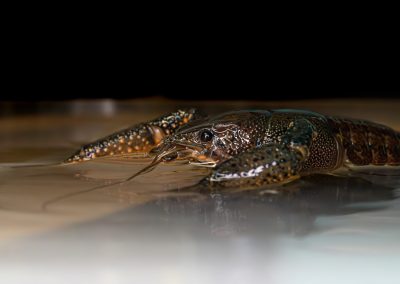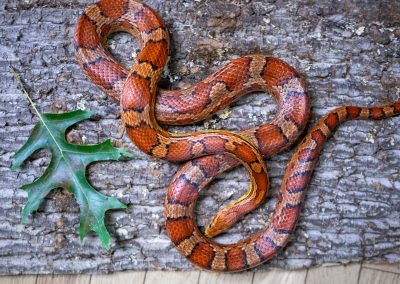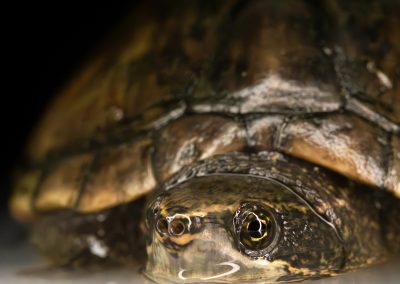Our Animals
The Balsam Mountain Trust provides care, love, and training to a collection of animals- most being native to Western North Carolina. These ambassador animals help bring life to our environmental education programs at schools, libraries, and other regional public facilities. It should be noted that these animals are not pets and have an essential role to play in educating our community about the species that call Western North Carolina home. These animals come to us, by and large, from wildlife rehabilitation facilities, where they are deemed unable to return back to the wild.
Every day, our staff and volunteers provide love and care to our ambassador animals. This includes providing enrichment, habitat cleanings, or even a walk around the “block” (for our opossums). We provide daily mental and physical stimulation for our animals. Training is a large part of the welfare of the animals. This allows us to create limited stressful situations when seeing the veterinarian or heading out on a program. We have a choice-based policy on all animal interactions and take pride in supporting their own decision-making processes.
Click on the tabs below to learn more about each of our animals’ stories and some natural history!
- Apollo, Harris's Hawk
- Cheyenne, Red-Tailed Hawk
- Luna, Barn Owl
- Ashe, Eastern Screech Owl
- Toad, American Toad
- Orville, Corn Snake
- Wilbur, Black Rat Snake
- Elsie, Sinaloan Milk Snake
- Tilia, Virginia Opossum
- Hermione & Merlin, Eastern Box Turtles
- Elohi, Mud Turtle
- Daksi, Musk Turtle
- Hazel, Virginia Opossum
- Monsieur Moustache, Crawfish
- Ama, Adult Morphed Axolotl
- Invertebrates
ent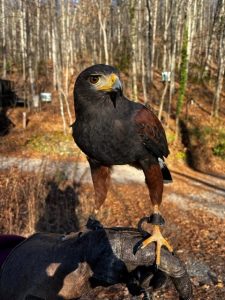 Apollo ws
Apollo ws
Parabuteo unicinctus
Apollo was born into managed care by an organization that provides raptors for falconry and education. He hatched in May 2014 in Oregon and came to us soon after. Apollo is incredibly smart and is able to solve a lot of his puzzle feeders for his diet. He also LOVES to shred a head of lettuce!
Did You Know?
- Harris’ hawks’ intelligence and social nature make them popular birds for falconry.
- In the wild, they often hunt in groups of 2-6 allowing them to take down larger prey. This is extremely unusual for hawks who almost always hunt solo.
- This species is native to the southwestern United States where they are commonly seen perching and nesting on saguaro cacti. They range into Central and South America.
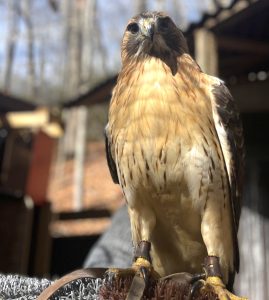
Buteo jamaicensis
Cheyenne was taken from the wild illegally after just leaving the nest. She had not yet learned to be a wild hawk. Her partial imprinting on humans makes her unable to be returned to the wild. She hatched in 2011 in Illinois. Cheyenne is a very confident bird and can be heard at any point of the day vocalizing to all of the local crows and other Red-tailed Hawks to keep away from her house! She loves to shred things like newspapers and boxes.
Did You Know?
- One of the largest and most common raptors in North America, red-tailed hawks are often seen surveying roadsides from electric poles and dead trees.
- Despite their large size and average 4 ft. wingspan, these hawks only weigh around 3 lbs. This doesn’t stop them from taking down prey up to 5 lbs.!
- Red-tailed hawks typically mate for life and aggressively defend their nests and territory.
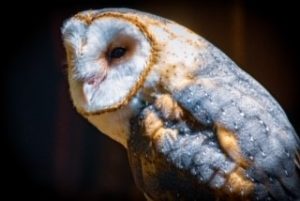
Tyto alba
Luna was born into managed care by an organization providing education raptors. She hatched on April 24, 2014, in New York. Luna is by far one of our most vocal ambassadors, and has many different noises to communicate with us what she is wanting or not wanting! She has a ton of personality and loves to take a big stretch every AM. Like all barn owls, she is most busy at night but also dusk and dawn.
Did You Know?
- Barn owls have the best hearing of any animal ever tested. They are able to catch live mice in a pitch-black room!
- They have been associated with the supernatural in folklore all over the world, probably due to their eerie scream-like call.
- Barn owls are the most widely distributed owl in the Northern hemisphere (referred to as circumpolar) with slight variations in size and color. The ones in North America are the largest.
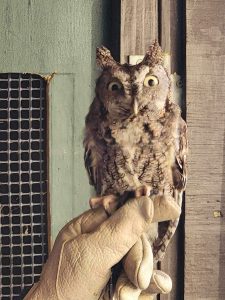
Megascops asio
Ashe came to us in 2020 from a local rehabilitator and is non-releasable. He is a grey morph screech owl, in comparison to our other morph- the red morphs. Ashe enjoys searching for “super worms”, the occasional dip in his water pan, and sitting on his perch near his tree in the sun in the very early hours of dawn.
Did you know?
- Eastern screech owls are cavity dwellers and are typically found in tree “snags” or former woodpecker holes.
- These owls are small in size but mighty, preying on small rodents, as well as reptiles and insects.
- They are nocturnal and are great at camouflage, so will not likely be seen but can be heard with their vocalizations which sound much like a small horse whinny!
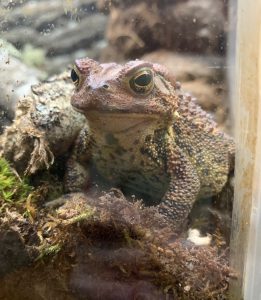
Anaxyrus americanus
Toad was raised as a tadpole here at the Trust and was hatched in 2016. She is a huge star amongst those who have met her and is extremely interactive with humans. She is very food motivated and loves crickets and worms! She loves to sit in her pool and being the first ambassador to meet when you walk in the door of the nature center.
Did you know?
- The American Toad is the largest toad species in North Carolina
- Toads prefer uplands to the watery habitats of frogs, and they hop rather than leap like frogs.
- State archeologists have unearthed toad bones from Native American burial sites dating as far back as
the 1600s!
*NCWRC species profile

Pantherophis guttatus
Orville is a red rat snake (or corn snake) and came to us in 2016. He was a former pet and turned in to a local rehabber before he found his forever home here at the Trust. Orville is a very gentle snake and likes to hang out in his plant pot full of moss as well as exploring around the nature center and being taken for walks in the sun.
Did you know?
- Corn snakes most likely get their name from the underside of their belly which resembles a checkered pattern of corn or maize kernels in Native American corn.
- Rat snakes are constrictors, which means they coil around prey until it is defeated and then will ingest it.
- They are diurnal, which means like humans, these snakes are active during the day and sleep at night.
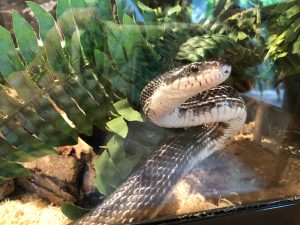
Pantherophis alleghaniensis
Wilbur is our resident Eastern Black Rat Snake and came to the Trust in 2021. He was taken from the wild as a hatchling in 2019 and surrendered to a local rehabbed prior to coming to us. Wilbur likes to experiment with how small of a space he can fit his 6-foot-long body into! He is our master escape artist and has a ton of personality. He also enjoys exploring around the nature center and being taken for walks in the sun.
Did you know?
- E. Black Rat Snakes can easily reach up to 7 ft long!
- They are excellent swimmers and climbers.
- Constrict their prey (typically rodents) before ingesting.
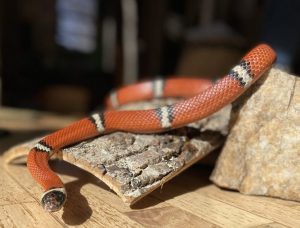
Lampropeltis triangulum sinaloae
Elsie is a Sinoloan Milksnake and is estimated to be at least 9 years old. She is native to Mexico but is in the same family as our native Scarlet Kingsnakes. Elsie is truly nocturnal but after so much time with us she has become more and more active during the day- she will absolutely “beg” when it comes to feeding day and is small in size compared to our rat snakes. However, her appetite says otherwise!
Did you know?
- The term ‘kingsnake’ refers to any snake in the genus Lampropeltis. This includes milk snakes, which belong to the species Lampropeltis triangulum.
- There are 25 different subspecies of milk snakes known throughout their geographic range, all with slight color variations. The Sinaloan milk snake has red bands separated by smaller black and yellow bands.
- Like other king snakes, they have some immunity to the venom of venomous snakes they consume.
*Smithsonian’s national zoo & conservation biology institute

Didelphis virginiana
Tilia, a Virginia opossum came to us in late 2022 from Appalachian Wildlife Refuge. She was struck by a car which resulted in her not being able to take care of herself in the wild. But not before she gave birth to 7 healthy babies who were all released thanks to App Wild. Tilia has been a treasure ever since coming to us, she takes long walks on the grounds on her leash and loves to crunch on apples and bananas.
Did you know?
- Opossums will “play dead” by an involuntary response to stress or fear.
- The Virginia opossum has more teeth than any other North American Mammal, 50 in total!
- They have immunity to snake venom in their native range, with one exception, the coral snake.

Terrapene carolina
Hermione was found
Merlin was found on a construction site, a dangerous place for a slow-moving turtle. Despite several relocation attempts, he kept returning to his “home” so a wildlife rehabilitator determined he would be safer in captivity. We estimate he hatched in the 1970s.
Did You Know?
- Their name comes from the “hinge” on their bottom shell that allows them to seal themselves in to thwart predators.
- Males have orange to red eyes and females have brown to golden eyes.
- Box turtles are completely terrestrial and cannot swim. They forage for greens, fruit, and insects on the forest floor.
- State reptile of North Carolina

Kinosternon subrubrum
Elohi (“earth” in Cherokee) came to us from Appalachian Wildlife Refuge in late 2022. She was relocated from another Nature Center that was impacted by a natural disaster. Prior to this, she was a surrender. She will now live out her days at the Trust with a belly full of mealworms and ample space.
Did you know?
- Eastern mud turtles are semi-aquatic. They are not strong swimmers and usually crawl along the bottom.
- Hatchling mud turtles are often mistaken for snapping turtles. An easy way to tell the two apart is a mud turtle has a larger, hinged plastron and snapping turtle hatchlings have a very small plastron and a long tail.
- Eastern mud turtles prefer shallow and sluggish bodies of water. They are able to tolerate brackish water and are sometimes encountered in salt marshes.
*info from Eastern Mud Turtle (herpsofnc.org)

Sternotherus odoratus
Daksi (“turtle” in Cherokee) is our musk turtle. He came to us in late 2022 also from App Wild with Elohi, and the Trust will now be his forever home.
Did you know?
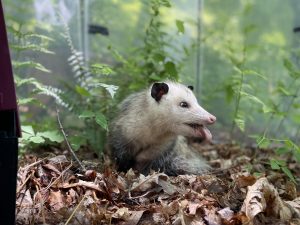
Didelphis virginiana
Hazel is a Virginia opossum who came to us in late 2023 only a few months old. We gave her a forever home after a licensed and local rehabilitator deemed her non-releasable by state criteria. Hazel is a female opossum with no tail due to an accident while only a couple of weeks old. All opossums need their tails, but females especially need them for all things entailing rearing young (or joeys in an opossum’s case). Hazel is full of energy and has a ton of spunky personality- she is 100% opossum, except that she is a picky eater! Her favorite treat is peanut butter.
Did you know?
- Opossums do not consume as many ticks as has been “advertised” in recent years, and this study was blown widely out of context. However, they are still vital to the regulation of our native ecosystem and do no harm.
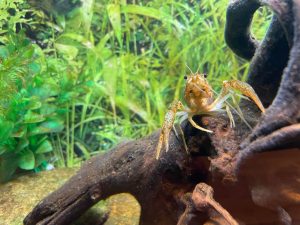
Cambarus bartoni
Crawfish was rescued from a pet store as a feeder- he is a wonderful representative for our local and important plethora of crayfish species here in WNC. He has an impressive “moustache” or antenna often seen feeling around and assisting in his wonderful set of senses. He really enjoys a wiggly worm or an algae disc as well as defending his tank by approaching with claws (chelipeds) raised and ready to rumble!
Did you know?
- Crayfish have the ability to regenerate their lost limbs (claws or legs) with every molting process. However, unlike other body parts, they cannot regenerate the eyes.
- Crayfish are omnivores but can be very aggressive to one another. If multiple are in a tank or enclosed area, one will ultimately kill the other.
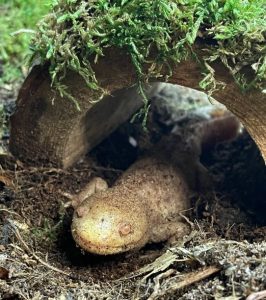
Ambystoma mexicanum
Ama is our albino adult morphed axolotl! “Ama” is the Cherokee word for water. Axolotls are native to the waters of Mexico and are paedomorphic (they retain their larval traits throughout adulthood). However, Ama is a rare exception of axolotls in the pet trade who have morphed out of their aquatic stage to a terrestrial salamander. This phenomenon is dangerous and often lethal to the individual and has occurred under unusual circumstances. A few, like Ama, make it out as healthy salamanders and live lives much like our Western North Carolina native, the spotted salamander. Ama is a rescue from the pet trade and has a ton of personality and a wonderful appetite. She loves to hunt for crickets and to take a long dip in her pool.
*To learn more about the language of the first peoples, read here Cherokee Nation Language Department
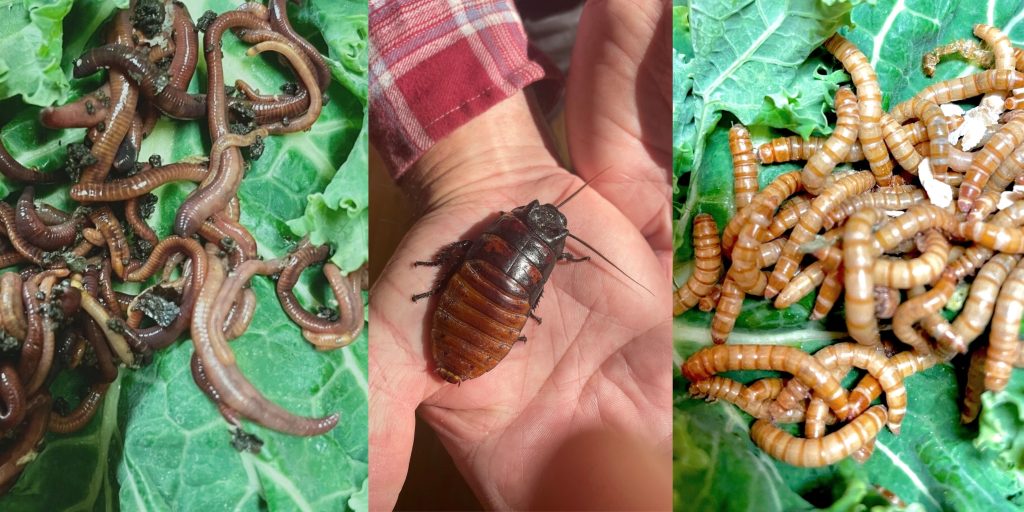
Invertebrates are a vital part of the ecosystem; therefore, we raise a few different types for nourishment to our other animal residents and also use these critical critters to educate. Pictured, we have Red Wigglers (Eisenia Fetida) which we grow in a vermicompost system here. Second, is our Madagascar Hissing Cockroaches (Gromphadorhina portentosa) which make wonderful ambassadors. Lastly, we grow mealworms (spp.) for feeders and education!
Check out these portraits of our Animal Ambassadors
We were fortunate enough to have a local wildlife photographer, Jacob Long, take these amazing portraits of our animal amassadors. They are all so unique and important to our work here are the Trust and we appreciate being able to share a glimpse of their wonder though these photos with everyone. See more of Jacob Long’s photogrpahy below!





